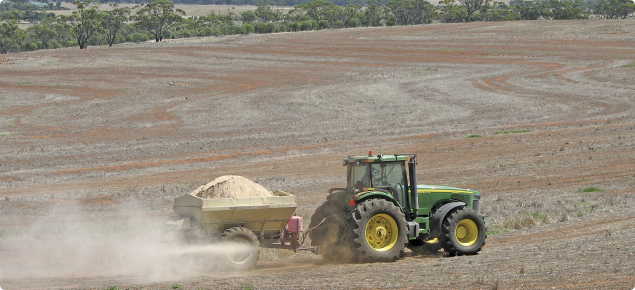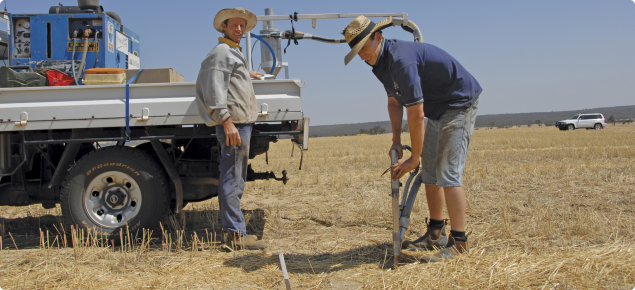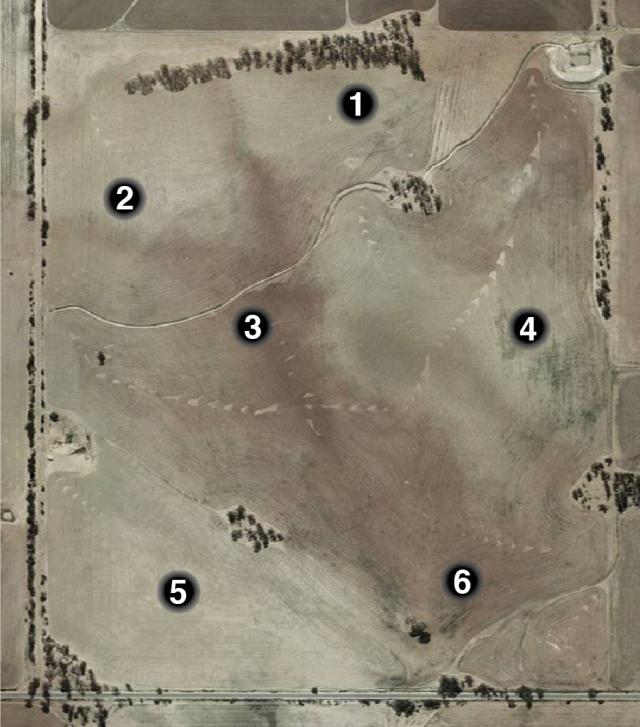Appropriate pH
The Department of Primary Industries and Regional Development (DPIRD) recommends soil pHCa values at or above 5.5 in the topsoil and 4.8 in the subsurface. These values have been developed based on hundreds of trial-years of data. Maintaining topsoil pHCa above 5.5 will treat ongoing acidification and ensure that sufficient alkalinity can move down the soil profile and treat subsurface acidification. The effects of aluminium toxicity in the subsurface are minimised if the pH is above 4.8.
Soil pH test results can be interpreted using DPIRD targets as a basis. If the top and subsurface soil pH values are at or above target values, only maintenance levels of liming will be required to counter ongoing acidification due to agriculture.
If the topsoil pHCa is below 5.5, recovery liming is recommended to prevent the development of subsurface acidity, even if the subsurface pHCa is currently at 4.8. When the topsoil pHCa is below 5.5, insufficient alkalinity can move down to counter ongoing acidification in the subsurface and the pH is likely to drop. If the subsurface pHCa is below 4.8, liming to maintain (or recover) topsoil pHCa at or above 5.5 is essential and subsurface pH should be monitored in three to four years so that the liming rates can be adjusted if insufficient alkalinity has moved down to treat the subsurface acidity.
Maintenance liming
Knowing how farming system inputs and exports contribute to soil acidification will help to calculate the amount of lime required to counter ongoing soil acidification due to agriculture (maintenance liming).
Different amounts of alkalinity are exported in various farm products and need to be replaced in the form of lime to prevent soil acidification (Table 1).
| Product removed | Component | CaCO3 equivalent kilograms per tonne (kg/t) |
|---|---|---|
| Wheat | grain | 9 |
| Barley | grain | 8 |
| Triticale | grain | 7 |
| Cereal | whole tops | 20 |
| Canola | grain | 2 |
| Lupin | grain | 20 |
| Lupin | whole tops | 60 |
| Lucerne | hay | 60 |
| Mixed grasses | hay | 30 |
| Subclover | whole plant | 40 |
| Sheep | dung | 25 |
| Sheep | urine | 9 |
| Sheep | lambs | 3 |
| Sheep | wool (6kg/sheep) | 0.4 |
The amount of lime required to counter the acidifying effects of common nitrogen fertilisers is given in Table 2. Ammonium fertilisers are the most acidifying. Elemental sulfur can contribute to soil acidification when it is converted to sulfate (the form that can be taken up by plants), however, relatively little elemental sulfur is applied in Western Australian farming systems and its contribution is small compared to ammonium fertilisers. If sulfur is applied in the form of sulfate, as in calcium sulfate (gypsum) it is non-acidifying. Phosphate fertilisers are non-acidifying.
| Nitrogen fertiliser | CaCO3 required to neutralise nitrogen addidtion (kg CaCO3/kg nitrogen)1 None leached | CaCO3 required to neutralise nitrogen addidtion (kg CaCO3/kg nitrogen)1 100% leached |
|---|---|---|
| Ammonium sulfate (Agras #1, MAP) | 3.6 | 7.1 |
| Ammonium nitrate (Agran) | 0 | 3.6 |
| Urea | 0 | 3.6 |
| DAP | 1.8 | 5.4 |
| Potassium nitrate | -3.62 | 0 |
| Sodium nitrate | -3.62 | 0 |
Typically, a wheatbelt farming system operating a winter crop/pasture rotation in WA has an acidification rate equivalent to 25-345 kilograms per hectare per year of pure calcium carbonate (NLWRA 2001). Required liming rates can only be estimated and monitoring of the soil pH profile every three to four years is recommended so the liming program can be refined.
Recovery liming
Applying agricultural lime is the most cost-effective way of treating soil acidity. The amount of lime required will depend on the current pH profile, soil type, rainfall, farming system and lime quality. To avoid wasting resources, always apply sufficient lime. Target specific areas if you can’t do it all.
Estimating the amount of lime required to recover acidic soil to recommended pH targets is complicated. Enough lime needs to be applied to treat ongoing acidification as well as the already acidified soil (Figure 1).
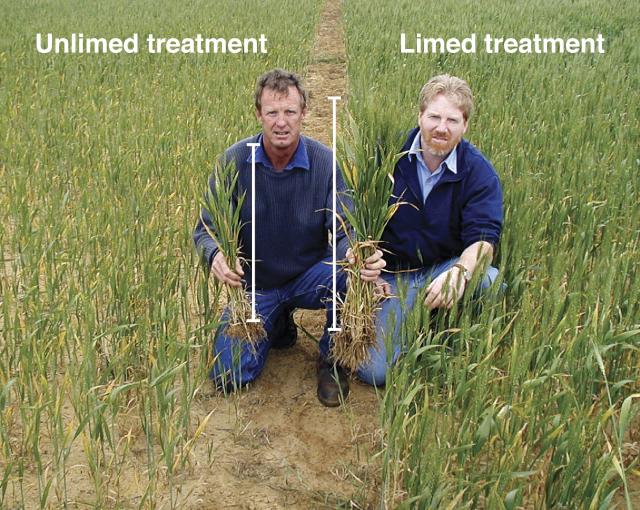
The rule-of-thumb guide (Table 3) indicates of the amount of lime that may be required on sandy soils over five years to achieve pHCa above 5.5 in the topsoil and 4.8 in the subsurface after 10 years. Where more information is known about the farm and farming system, a 10-year liming plan can be developed. Increases in pH will depend on soil type, rainfall, lime quality and quantity applied and other farming practices as well as the soil pH profile. Expert advice should be sought for individual recommendations.
| Soil depth (cm) | pHCa | Lime amount over five years (tonnes per hectare) |
|---|---|---|
| 0-10 | <5 | 2t/ha |
| 0-10 | <5.5 | 1t/ha |
| 10-20 | <4.5 | 2t/ha |
| 10-20 | <4.8 | 1t/ha |
| 20-30 | <4.5 | 1t/ha |
| 20-30 | <4.8 | measure pH in three years |
Monitoring the topsoil and subsurface soil about every three years is very important when liming to recover acidic subsurface soil. This will allow adjustment of the liming schedule as the soil pH increases or if it does not respond as expected. It is essential to maintain the topsoil pHCa above 5.5 for alkalinity to move down to treat acidity in the subsurface soil.
Liming effectively
The best use of lime is achieved when you know how much to apply and where to apply it. Monitoring soil pH in the topsoil and subsurface identifies priority areas which allows liming to be targeted to achieve the best economic return. More lime can be applied where necessary, rather than a lower rate over whole paddocks.
The old recommendation of 1 tonne per hectare (t/ha) of lime every 10 years applied over the whole paddock is usually not the most effective way of applying lime; some areas will receive too much lime and others too little. Overall production has increased on most farms due to improved farming practice and so acidification of the soil has also increased. Current liming recommendations, to achieve appropriate pH, are often greater than 2t/ha but need to be based on soil pH test results so that the lime can be targeted to management areas within paddocks as required.
Where it is not practical to lime all paddocks that need it, you need to prioritise, but always apply the recommended rate of lime that will treat acidity in the surface and subsurface. If your best performing paddocks are at risk of acidifying, give them the highest priority. Next, identify the soils that are likely to give the greatest benefit from liming. For example, soils where an acidic layer restricts root growth into good soil below. These may not be the most acidic soils.
Guessing how much lime to apply from only topsoil samples can lead to inadequate lime application. Applying too little lime does not treat subsurface acidity; yield will continue to be lost as subsurface pH continues to decline and inhibit root growth.
Figure 2 demonstrates the hazards of only testing the topsoil. Testing the topsoil could show that the topsoil is acidic but nothing about the subsurface. The universal indicator stain reveals that this soil profile is acidic to about 40cm with good soil below. Sufficient lime to treat the topsoil based only on topsoil testing would be insufficient to treat the acidic layer down to 40cm and the barrier to root growth would still exist. Testing the 10-20cm and 20-30cm layers would allow liming rates to be determined to treat the acidic layer and allow root access to the good soil below. Soils with this kind of pH profile are likely to show large responses to liming.
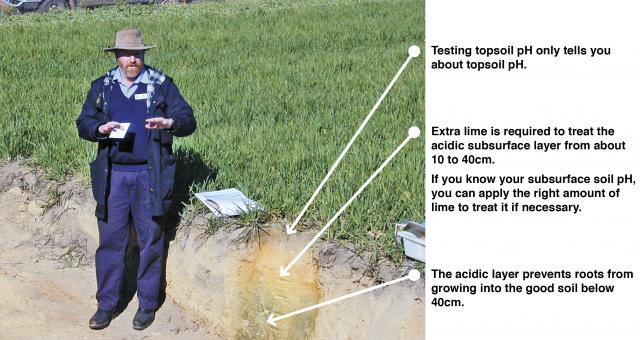
A worked example
The following example shows the benefits of monitoring the soil pH at 0-10, 10-20 and 20-30cm. There is a great danger of underliming if only topsoil pH is taken into account, by almost 60% overall in this example and at the same time unnecessarily liming in some areas.
This example is worked from actual pH data from the paddock shown in Figure 3. Where only the topsoil pH values are considered, the recommended lime application rate can only be given as a range because the pH of the subsurface soil may be anywhere from ideal to extremely acidic. The recommendation can be refined where the soil pH profile is known (Table 4).
Three commonly used liming options were considered (Table 5):
- No soil pH values are taken into account. Lime is applied at 1t/ha over the whole paddock. Using this option, no area would receive the right amount of lime. Not enough would be applied at sites 1, 2, 4 and 5 and too much would be applied to sites 3 and 6.
- Only the topsoil pH values are taken into account. Lime is applied to targeted areas at the lowest rate recommended. The total amount of lime applied would be similar to option 1. The correct amount of lime would be applied at three sites, but at sites 2, 4 and 6 too little would be applied and the subsurface soil would continue to acidify.
- pH values from 0-10, 10-20 and 20-30cm are taken into account. Lime is applied to targeted areas at the recommended rates.
| Site | Soil type | Soil pH at 0-10cm | Soil pH at 10-20cm | Soil pH at 20-30cm | Recommended lime over 10 years based on pH from only 0-10cm (t/ha) | Recommended lime over 10 years based on pH from 0-10, 10-20 and 20-30cm (t/ha) |
|---|---|---|---|---|---|---|
| 1 | sandy loam | 5.0 | 4.6 | 4.8 | 2-4 | 2 |
| 2 | loamy | 5.3 | 4.3 | 4.6 | 2-4 | 3 |
| 3 | loamy clay | 6.9 | 7.7 | 8.0 | 0-3 | 0 |
| 4 | sandy loam | 5.6 | 4.5 | 4.5 | 1-3 | 2 |
| 5 | sandy loam | 4.9 | 4.1 | 4.1 | 2-4 | 4 |
| 6 | loamy clay | 6.7 | 7.2 | 7.9 | 0-3 | 0 |
| Site | Area (ha) | Lime (t) required over 10 years for Option 1 | Lime (t) required over 10 years for Option 2 | Lime (t) required over 10 years for Option 3 |
|---|---|---|---|---|
| 1 | 10 | 10 | 20 | 20 |
| 2 | 10 | 10 | 20 | 30 |
| 3 | 15 | 15 | 0 | 0 |
| 4 | 23 | 23 | 23 | 46 |
| 5 | 16 | 16 | 32 | 64 |
| 6 | 16 | 16 | 0 | 0 |
| Total | 90ha | 90t | 95t | 160t |
The total amount of lime applied under Option 3 would be 1.8 times more than Option 1. The method used would be to immediately spread 2t/ha on all areas that require liming. Then in 2-4 years time, 1 or 2t/ha would be spread on the areas that required 3 or 4t/ha over the 10-year period. Re-sampling the soil in three to four years would allow adjustment of liming rates as necessary.

